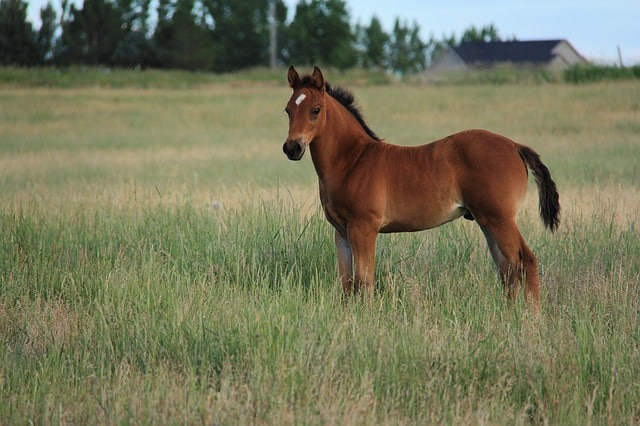
Autumn each year is usually the time that sports horse foals are being weaned. It can be a stressful time for mares, foals and handlers alike. In the natural world mares and foals would remain running together and the mare would gradually wean the foal herself usually at a much older age. So why do we insist on this form of enforced separation, and what is the best option for doing it?
Reasons for weaning.
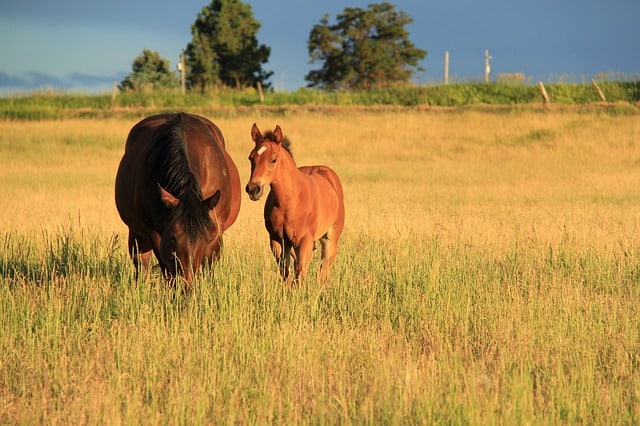
Weaning of foals is mainly driven by economics of commercial horse production breeders require foals to be well grown and mares to breed every year. Foals need to be in an optimum condition for sale as either weanlings or yearlings, weaning and producing them away from the mare is required to achieve this. Mares can then be fed according to their needs (either in foal or barren) and the weanlings fed a steady diet for optimal growth. Occasionally it is necessary to wean earlier than the normal 6 month age. Early weaning is often an enforced option – if the mare is doing the foal ‘too well’ and her milk causes them to grow too quickly. Or if the mare is not holding her condition despite adequate feeding or has suffered an injury or other trauma requiring special attention (eg a colic operation) then early weaning may be needed.
Most studs agree that 4-6 months is a suitable age for weaning. By this time the natural weaning process has already begun. The mare’s milk is less rich than when the foal was born, and the foal should have been eating solid feed for some time now. Foals begin to get independent and spend more and more time on their own in the paddock. It is also best to wean foals towards the end of summer and early autumn, when the weather is still reasonable, not too hot or too cold. Weaning is a stressful time, foals can get upset and sweat up with woolly coats they can easily get a chill, doing it when the weather is cold and wet or to hot can make the foal more prone to illness.
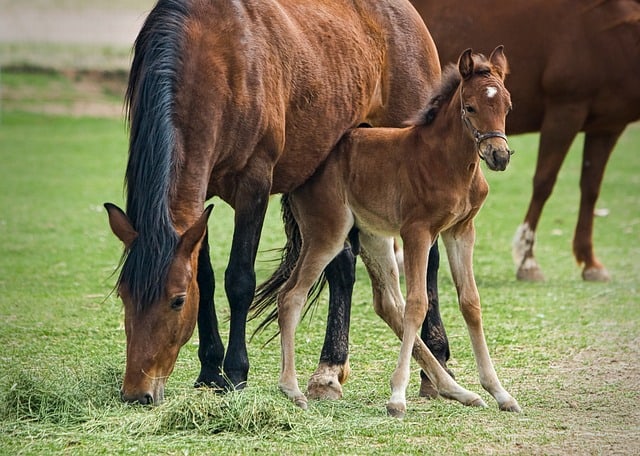
It is preferable if the foals are haltered and use to being handled. This makes for less stress.
Although some studs don’t handle foals until weaning, it is preferable to do this as it makes the weaning process much easier.
Creep feeding prior to weaning.
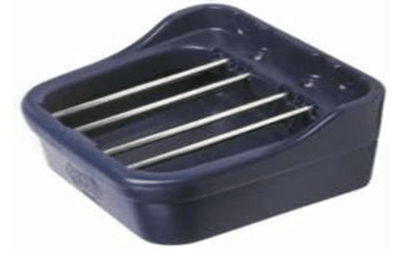
It is a good idea to have started to feed the mare and foal hard feed about one month prior to weaning. This will help prepare the foal’s digestive system for the switch from a predominantly milk diet to solid feed. Most foals are already eating hard feed alongside the mare by the time they are three months old. At this stage the gut is able to digest concentrates and fibre reasonably efficiently. However, be aware that some mares become possessive of their feed and act aggressively towards their foals, preventing them from eating hard feed. This behaviour can be copied by the foals and carried on in later years.
Foals should be encouraged to eat out of their own bucket. Creep feeding troughs can be used in the stable that prevent the mare from getting her nose into the feed.
This means not only do they get used to eating independently of their mothers, but also they can be fed a diet more appropriate to their needs. A creep feed formulated specifically for foals and weanlings, and plenty of good quality forage is best and will ensure even, steady growth patterns avoiding problems in later life.
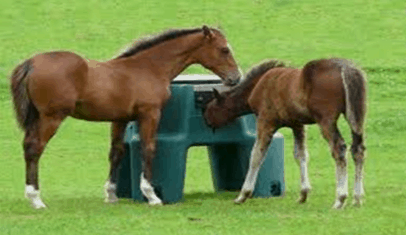
Creep feeding in the paddock can be carried out. Feeders range from home made pens that the mares cannot enter to super safe commercially produce moulded plastic hoppers.
Some feeders can be hung on the outside of the fence line and allow only the foals to get access to the feed. Be sure that as the foals grow they can still eat without getting their heads stuck or getting splinters from the wood.
Some studs will catch up the mares and foals daily and bring them into a stable. The mares are then tied up and both mare and foal are fed. This is time consuming but it ensures the foals are well handled, inspected closely on a daily basis and that they associate coming into the stable with a positive reward. This is a very helpful reinforcement for the future.
Methods of weaning.
Abrupt Method
This method is probably the most traumatic, but the quickest. A day is picked to wean the foal; the dam and foal are separated. If using the abrupt method it is usually best to take the mare from the foal. This allows the foal to stay in a familiar area and generally mares settle quicker than foals.
Large breeding stables generally use the Abrupt Method. They usually have a group of foals that have been raised together and will offer comfort to each other when weaning day occurs. Many times an older barren mare or good natured gelding is a “baby sitter” for these foals.
That familiar area must be safe and free from dangerous objects. A stable is ideal; some weaning boxes have a grill into the next stable so the foal is not totally isolated. The walls should be smooth and full height it should be well bedded with good banks. Buckets and feeders should be removed. When replaced ensure they have no handle on that the foal can get caught in. If there is a window it should be covered with unbreakable material. Any openings, such as a top door, should be closed.
Large breeding stables generally use the abrupt method. They usually have a group of foals that have been raised together and will offer comfort to each other when weaning day occurs. Many times an older barren mare or good natured gelding is a “baby sitter” for these foals.
The abrupt separation works best if the mare is taken out of sight and hearing range.
When the dam and foal can’t see or hear each other, the frantic behaviour will end sooner; but be prepared for several days of stress.
Once they are separated the foals will need to spend some time shut in. Foals can be paired up and allowed out to a small enclosed area for some exercise. It is not uncommon to put 2 foals into a stable together at weaning. However this is not as ideal as use to be thought. Studies have shown foals weaned in pairs in a stable are more stressed than foals weaned by themselves.
A study at Rutgers University in New Jersey showed that even though foals weaned in pairs were quieter (less frantic activity and whinnying), they suffered more immune suppression, which indicates more stress. Immune suppression can make them more susceptible to disease.
Care should be taken to ensure they are drinking water as 60% of foals don’t drink water while with the mare.
After a couple of days Foals can be returned to the paddock as long as they are away from the dams. As stated a gentle “nanny” can be a help. It will lead the way and help teach the foals to be lead in and out and to be caught.
Pied piper weaning.
This method is an adaptation of abrupt weaning but retains the herd structure for the foal. It is only practical if a group of mares and foals are kept. It allows the foals to be weaned when they are individually ready not just when it’s suitable for the group as a whole.
The mares are removed one at a time from the herd and the foals left with the herd. Foals are kept in a familiar environment, they have the companionship of other known animals and they have the leadership of the mares that are still left with the group. There is no one on one foal bonding as they are still in a group. This method still employs an abrupt separation of the mare and foal, care needs to be taken that the foal is in a safe environment when first separated, and the mare must be out of sight and sound when removed. Depending upon the number of mares in the herd this can take considerably longer than other methods of abrupt weaning.
Gradual Weaning .
This method is slower and considered by some to be more stressful. It prolongs the process of being separated. There are two types of gradual weaning methods.
Gradual Weaning Method 1
The mare is taken away from the foal for short periods of time each day. As the days pass the duration of the separation is increased. This is probably the most stressful method.
Some breeders liken it to taking a band aid off very slowly.
Gradual Weaning Method 2
This variation of the gradual weaning method is to stable the dam next to the foal. They can see each other, usually through a grill, but nursing is impossible. This method may be best for the breeder with one mare and nowhere to take the mare out of eyesight or hearing. Eventually
Fence line weaning.
Gradual weaning can be carried out in a pen or paddock situation. Mares and foals are in adjoining pens with mares on one side of the fence and foals on the other. During the first day or so feed the mares right by the fence, so mares and foals eat together and the foals have mares nearby for security. Then move the feed a little farther away as they become less dependent on having the mares right there. A few days later open another paddock so the mares have more room and can be farther away if they wish. After a while, the mares just leave and are no longer worried about their foals. By this time the foals are independent in their own group, pretty painless for mares and for the foals.“
Post weaning care of the mare.
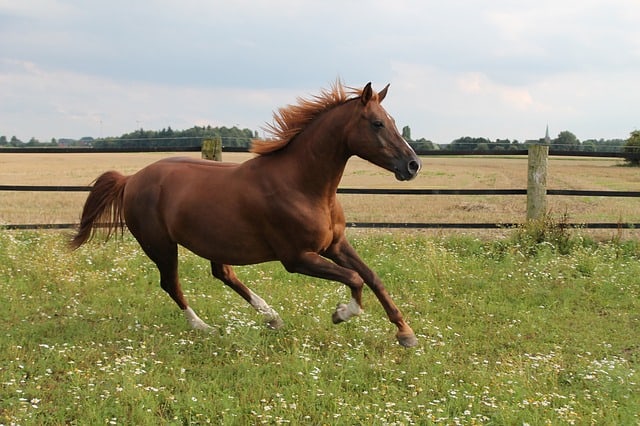
After weaning don’t forget about the mare. Most mares cope much better than their foals with the weaning process, but they must still be monitored to ensure they do not harm themselves in the immediate period after weaning. A paddock is the safest and least stressful environment for the mare to be placed into after weaning. It should be out of ear shot of the foals and the mare should have company of other horses. The mare should be placed on a basic paddock and hard feed stopped to help her dry off the milk. Exercise will help keep the udder from filling with milk.
It is best to do nothing to the udder other than monitor it for signs of mastitis. Do not be tempted to strip out the mare’s udder after weaning; this mimics suckling by the foal and encourages the udder to produce more milk when you want it to produce less.
Initially the udder will enlarge after weaning but the mare should remain bright and comfortable, and the udder will begin to reduce in size again after a few days.
Mastitis is uncommon in mares but requires veterinary attention if it occurs.
Watch for an udder that becomes hot, swollen and painful. The mare may be reluctant to eat and move, and may have a fever (temperature greater than 38.5°C). If you suspect mastitis call the vet to get appropriate treatment.
Mastitis is uncommon in mares but requires veterinary attention if it occurs. Watch for an udder that becomes hot, swollen and painful. The mare may be reluctant to eat and move, and may have a fever (temperature greater than 38.5°C). If you suspect mastitis call the vet to get appropriate treatment.
So which method of Weaning Foals is best?
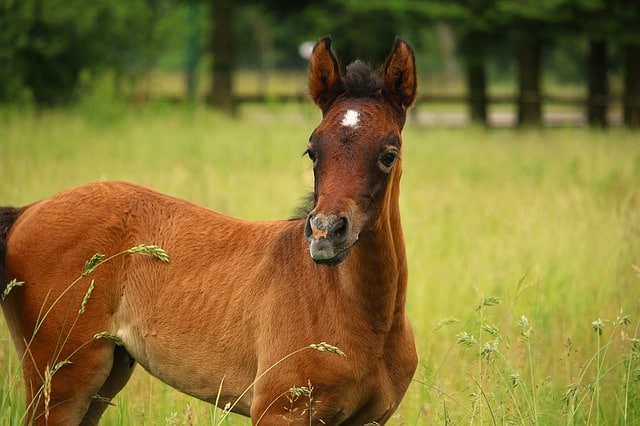
Many experienced horse breeders agree the “abrupt” or total separation method is best.
The method used is going to be decided by the facilities and requirements of each stud.
It offers a chance to start working with the foal and establishing a trainer/student atmosphere. It is also more practical for a commercial stud farm. If you happen to only have one foal to wean it may not be the most appropriate for you. At some point along the road the mare and foal will have to be separated and the longer they are together in a twosome the harder it becomes.
The better the pre-weaning handling is, the easier the foal will fall into a routine, while being less stressed. Always remember to have the foal in optimum health prior to the weaning process and be prepared for the foal to lose a little bit of condition post weaning, but it should soon pick back up.
This Article is written by Jessica Soley BHSI and was originally published in the October 2019 Issue of Irish Sport Horse Magazine.
